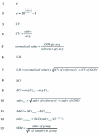Quantitative real-time PCR protocol for analysis of nuclear receptor signaling pathways
- PMID: 16604184
- PMCID: PMC1402222
- DOI: 10.1621/nrs.01012
Quantitative real-time PCR protocol for analysis of nuclear receptor signaling pathways
Abstract
A major goal of the Nuclear Receptor Signaling Atlas (NURSA) is to elucidate the biochemical and physiological roles of nuclear receptors in vivo. Characterizing the tissue expression pattern of individual receptors and their target genes in whole animals under various pharmacological conditions and genotypes is an essential component of this aim. Here we describe a high-throughput quantitative, real-time, reverse-transcription PCR (QPCR) method for the measurement of both the relative level of expression of a particular transcript in a given tissue or cell type, and the relative change in expression of a particular transcript after pharmacologic or genotypic manipulation. This method is provided as a standardized protocol for those in the nuclear receptor field. It is meant to be a simplified, easy to use protocol for the rapid, high-throughput measurement of transcript levels in a large number of samples. A subsequent report will provide validated primer and probe sequence information for the entire mouse and human nuclear receptor superfamily.
Figures






References
-
- Technotes Newsletter. Vol. 8. Ambion; 2001. The Top 10 Most common quantitative PCR pitfalls.
-
- Applied Biosystems: 1997. Relative Quantitation Of Gene Expression: ABI PRISM 7700 Sequence Detection System: User Bulletin #2: Rev B.
-
- Applied Biosystems: 2001. ABI Prism 7900HT User Manual.
-
- Applied Biosystems; 2003. Essentials of Real Time PCR.
-
- Morrison T. B., Weis J. J., Wittwer C. T. Quantification of low-copy transcripts by continuous SYBR Green I monitoring during amplification. Biotechniques. 1998;24:954–8. - PubMed
Grants and funding
LinkOut - more resources
Full Text Sources
Other Literature Sources

